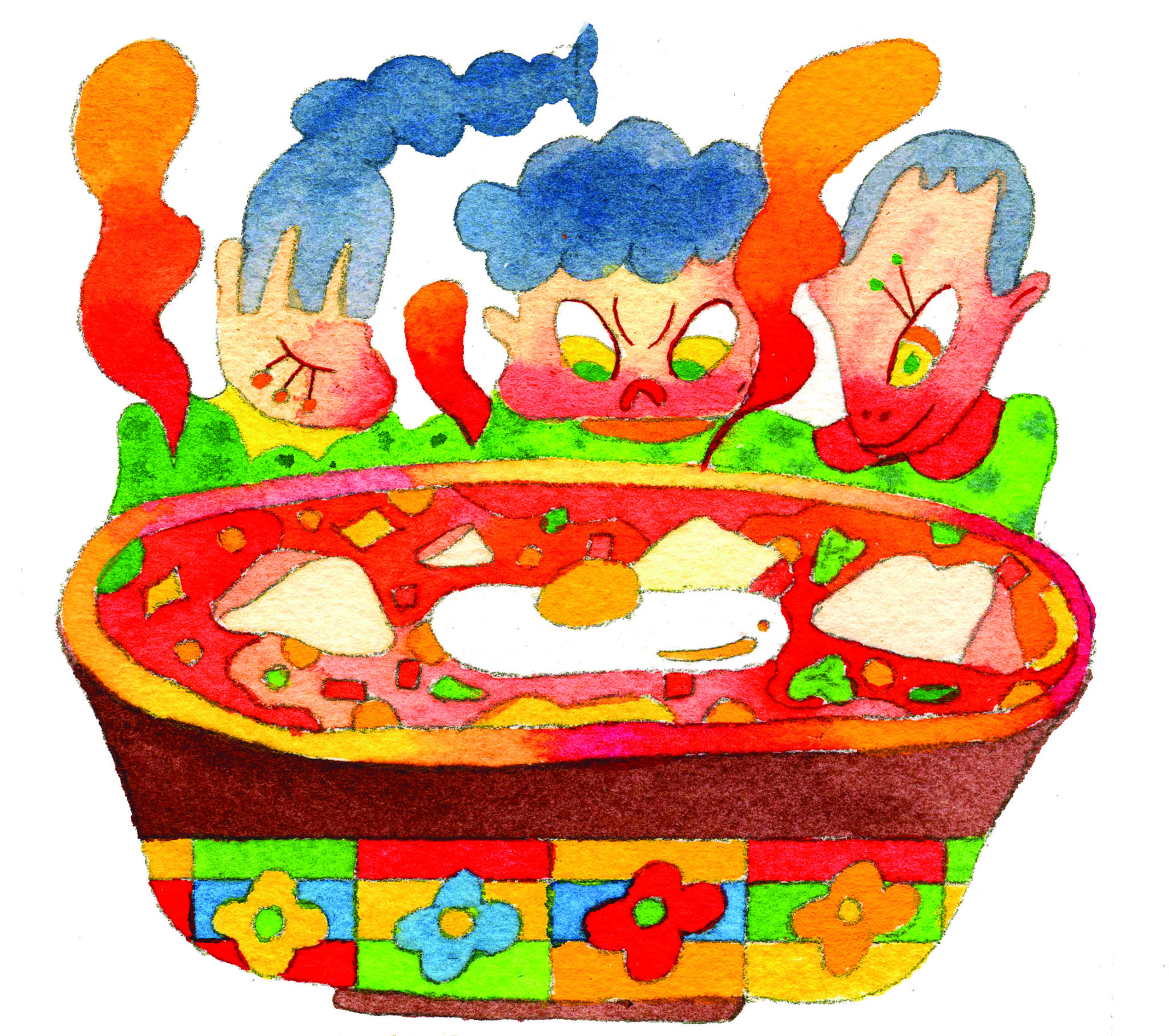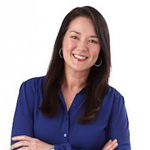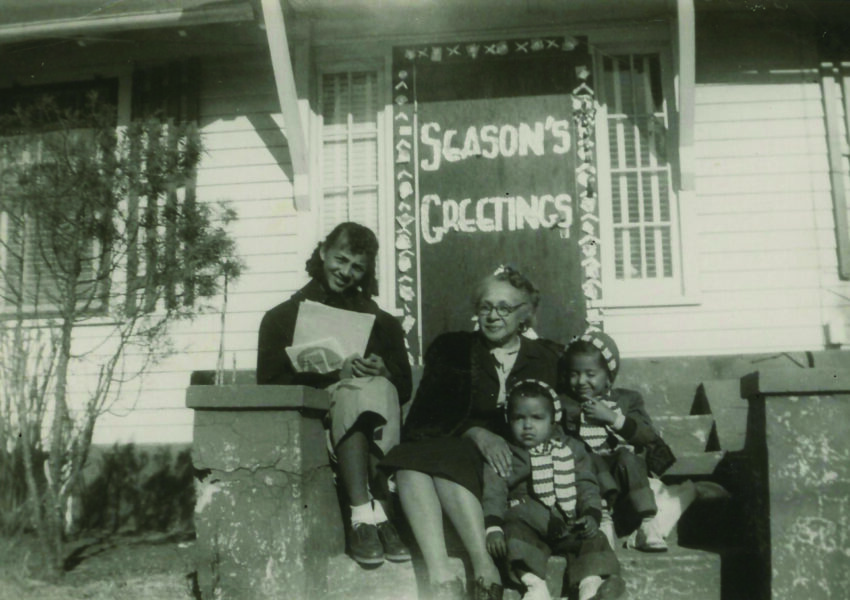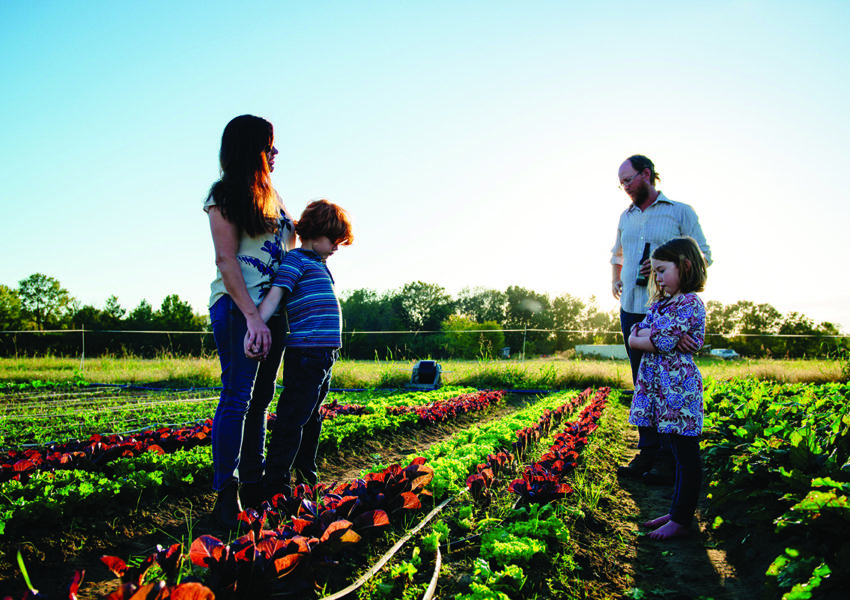Korean Montgomery From bowling alleys to barbecue
Story by Ann Taylor Pittman. Illustrations by Haejin Park.
Driving down Eastern Boulevard in Montgomery, Alabama, then over to the corner of Bell and Vaughn Roads, a roll call of signs hints at a sizable Korean population. Hangul lettering accompanies English to identify a hair salon, a chiropractor, a pest control company—but more than anything, restaurants. Eleven or so Korean restaurants dot the city, far outnumbering the two in my hometown of Birmingham.
![]()
I visit Korea Garden with my husband and our twin sons, hoping to chat it up with our server. This does not happen, as a profound language barrier presents itself. I whip out my business card and attempt to explain that I’d like to talk about the Korean community in town. Our server shyly giggles and hands over some menus. As she scurries away, the kids declare that they are “dying of awkwardness.” I switch my focus to the food; that, I can navigate. The boys share a cauldron of tteokguk, a brothy soup filled with chewy rice cakes; Patrick sidles up to a platter of japchae, slippery glass noodles tossed with beef and vegetables; and I dig into soondubu jjigae, a fiery tofu and seafood stew. I rethink my strategy.

I’m in Montgomery to research immigrant communities and, I hope, to sprout some new roots of my own. I’m a half-Korean Southerner, born and raised in Mississippi by a South Korean mom and a Mississippian dad, and though I look more Korean, I am decidedly American. Definitively Southern. When my mom immigrated to the States, her goal was to become American. She did, officially, and set her own cultural heritage aside so she and Dad could raise their two children as Americans. I don’t speak Korean, and I’ve only been to Korea once, five years ago. As I get older and try to raise my own children with some knowledge of their broader heritage, I yearn for more meaningful Korean connections. My little tiptoe trips to Montgomery opened up a new world to me, revealing a cultural and personal awareness that brought me face-to-face with one of my greatest fears: being exposed as a phony.
So what gave rise to this Korean community in Alabama’s capital city? Maxwell Air Force Base has long attracted an international community, though Koreans never exactly dominated it. The real catalyst was Hyundai Motor Manufacturing Alabama (HMMA), a Seoul-based company that announced plans for opening in 2002 and rolled out its first cars in 2005. Many Koreans have since come to Alabama to work for Hyundai, but that’s not the only stimulus. Interstate 85 connects Montgomery to West Point, Georgia, the site of Kia Motors Manufacturing Georgia (KMMG), another Seoul-based company and part of the Hyundai Motor Group. Along this route, seventy-plus Korean-owned suppliers, turning out flywheels and radiators and batteries, employ thousands of Korean nationals.
My little tiptoe trips to Montgomery opened up a new world to me, revealing a cultural and personal awareness that brought me face-to-face with one of my greatest fears: being exposed as a phony.
Counting the official Korean population of Montgomery is challenging; many of the jobs that call them here range from a few months to a few years. Those staying years bring families but, since they will return home to Korea, their aim is not to assimilate or immigrate. Protestant churches have become gathering places for the estimated 10,000 to 13,000 Koreans in the area; more than a dozen Korean churches have assembled in Montgomery since 2002.

To get a sense of the impact of this community, I visited a few stores. While Korean ingredients haven’t found their way into Winn-Dixie, a few items are in the local Costco. Seoul Market, a small but well-stocked grocery store, offers an astounding assortment of Korean ingredients, and H Mart, a major Korean-American supermarket with locations from Southern California to New York and New Jersey, has plans to open a Montgomery store.
I happily ate at several Korean restaurants as I conducted my research, noting that they fall into two camps: Places like Budnamu or Korea Garden call to a predominately Korean clientele, serving as a home away from home: Korean newspapers pile up in the entryway, and the staff speaks very little English. Restaurants with touchstones of Japanese and Chinese offerings appeal to a wider audience by bridging the cultural gap for diners less familiar with Korean food culture.
That’s because Korean eating customs can be intimidating, even baffling. You may not know to push the button on the wall when you need service, or that the spoons and chopsticks are in the wooden box at the end of the table. What are all the side dishes, and which food belongs to whom? Answer: Korean food is meant to be shared, out of the same dish. This can be a huge cultural barrier. For some, “my plate” is mine only, but in Korean culture, you are supposed to chopstick the food out of communal dishes. And that’s what I love—the instant intimacy.

All these observations aside, I needed to talk with some Koreans. With such a sizeable population, multiple organizations exist to foster better relationships between the greater Montgomery population and the Korean community that drives so much economic growth. I phoned and e-mailed for weeks before I could get anyone to talk with me. One person passed me to another, to another, each time saying in perfect English, “Sorry, I can’t help you,” or “my English isn’t very good.” I would gently protest. Still, no dice. Each time I reached out I would stress that I’m half-Korean, thinking that might give me an “in.” Didn’t work. I was turned away so many times that I felt like folks were wary of me.

Two Americans would serve as my way in. One was Jeanne Charbonneau, a cultural liaison employed by the mayor’s office. When she first came out of retirement to take this job in 2002, it was supposed to be temporary, but she still holds the position today. It’s that important to the city. Despite the broader rhetoric of outsiders taking American jobs, that negativity is absent here because “whether it’s strictly HMMA and the suppliers or if you’re looking at all the secondary and tertiary jobs that come with that, they probably impact forty to fifty thousand jobs in the region,” she explains. Charbonneau helps new Korean families get settled—assisting with everything from housing to blue immunization forms to music lessons.
The other American was Christa Springs, assistant program coordinator at A-KEEP, Alabama-Korea Education and Economic Partnership. I was humbled by Springs, an African American student who took an interest in Korean culture and has immersed herself in the community—working for A-KEEP, forming deep connections, learning the language. She is way more Korean than I. Springs introduced me to A-KEEP executive director Meesoon Han, a transplanted Korean who first came to Montgomery fourteen years ago with her husband, who was stationed at Maxwell.

And I eventually made contact with local attorney Soo Seok Yang through the Korean-American Association of Montgomery. I would come to know Yang; his wife, Doh Ah Kim, an attorney in the governor’s office of minority affairs; their four beautiful children; and Yang’s mother, visiting from Korea. Yang talked of Korea’s history, saying it’s critical to understanding the culture. For centuries, Korea was a country that suffered invasions yet never invaded another country. The Japanese occupation from 1910 to 1945 nearly wiped out Korean culture—the language and currency were banned, and Koreans were forced to adopt Japanese names. These wounds are recent enough to still have a deep impact on the national story.
Meesoon Han would also instruct me on the swift economic rise of South Korea and the cultural ramifications of that ascent. After being split into the North and South in 1945, South Korea grew from extreme poverty to economic prosperity by the mid-1980s; it’s known as the “economic miracle.” Han explained that this happened because the country chose to focus exclusively on itself. In reaction to all their adversity, Koreans became intensely tied to their culture, much more nationalistic, and incredibly protective of themselves.
Then it all clicked. I told Han that I sensed suspicion from the Koreans I tried to connect with. “That’s right. Oh, yes. That’s Korean,” she responded. I floated the same idea past Charbonneau. Her reply: “You come in as a half-Korean person not speaking any Korean, and there is going to be a bias against you.” I must stress that this was all rather subtle; no one was ever exactly rude to me. But I felt something, and now I had confirmation. Through what was at best naiveté and at worst arrogance, I thought I would enjoy instant familiarity with the Koreans of Montgomery—because I’m Korean, too, or at least I say I am. In reality, I’m Korean-American, heavy emphasis on the second word. And it was obvious to everyone but me.
You share food out of the same dishes. And in doing so, you become family.
Yet I come back to the language of food and family. Yang told me about taking an American friend to the new Korean restaurant near the bowling alley. When the banchan—all the little side dishes—came to the table, Yang explained each dish’s cultural and personal significance. Because that’s what we all do, no matter our background: We share ourselves through our food. I do this when I eat Korean food with American friends.

Mrs. Han taught me a word whose meaning would soothe my cultural identity crisis. Sikgu is one of the Korean words for family. “Sik” means rice, and “gu” means mouth. Sikgu, this word for family, means eating and sharing food. This is the way you eat a Korean meal; you share food out of the same dishes. And in doing so, you become family.
I have since made the drive back to Montgomery with my Korean mom to have dinner with the Yang family. They opened their home to us, shared food with us, and embraced us warmly. Sikgu. I am a member of the family—a large, Korean family.
 Ann Taylor Pittman is the executive editor at Cooking Light. She delivered a version of this story at the SFA’s Food Media South 2017 in Birmingham, Alabama.
Ann Taylor Pittman is the executive editor at Cooking Light. She delivered a version of this story at the SFA’s Food Media South 2017 in Birmingham, Alabama.




